Chandpur Paper’s Journey Towards Zero Variance in Basis Weight Control
The Pursuit of Perfection
Chandpur Paper, a leading manufacturer of MG Poster Paper in the paper industry, embarked on a transformative journey to perfect its basis weight control—one of the most critical aspects of paper production. The story begins with a simple yet compelling goal: ensuring uniformity in the weight of paper, measured in grams per square meter (gsm), which directly impacts downstream operations such as printing, lamination, and coating and helps ensure seamless runnability on high speed machines.
But before we delve deeper, what is GSM?
GSM, or Grams per Square Meter, is a widely recognized metric used to quantify the areal density of paper and related substrates. It specifically denotes the mass, in grams, of a single sheet of paper with an area of one square meter. This parameter serves as a standardized indicator of paper thickness and weight, directly influencing its mechanical properties, printability, and application suitability.
The GSM value is obtained by measuring the mass of a paper sample and extrapolating it to a one-square-meter basis, ensuring uniformity and comparability across different types and grades of paper.
The Initial Challenge
Manual Processes and Struggles
The early days saw Chandpur Paper relying on manual processes to manage basis weight control. The management worked tirelessly, using time series analysis to monitor gsm levels and manually adjust operations. This process was undertaken as a last resort due to the absence of alternative solutions, though it was hindered by significant inefficiencies. The process required immense effort, involving the careful collection of multiple samples, detailed data compilation, and thorough analysis—an arduous and demanding task.
Yet, fluctuations in the paper’s gsm persisted. After one such exercise of time-series analysis, it was identified that fluctuations of basis weight occurred due to mechanical issues like pulsations from holey roll, an equipment installed inside the headbox. More such issues were identified, and fixed to bring the gsm variations within a narrower range, thus, improving overall gsm profile.
It became clear that while these early efforts helped maintain a reasonable level of control, they weren’t sustainable for long-term success.
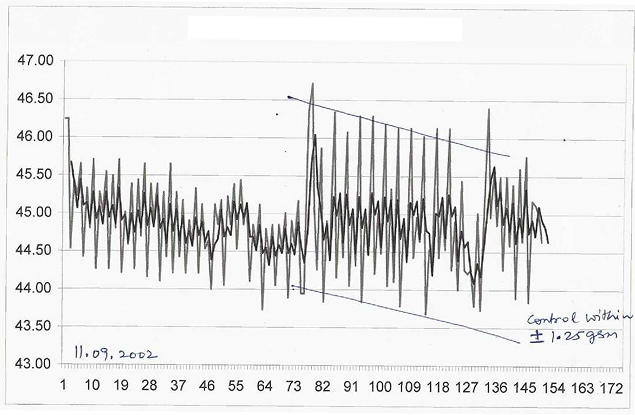
Holey Roll Graph
Visualizing the challenge: This graph highlights the basis weight variations caused by holey roll pulsations, showcasing the analytical rigor applied to identify and address mechanical issues for improved gsm control.
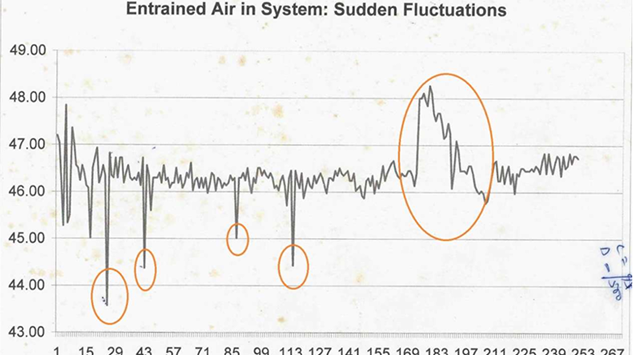
Entered Air Graph
Tracing instability: This graph captures the abrupt fluctuations caused by entrained air in the system, emphasizing the need for sustainable long term solutions to maintain control and operational efficiency.
Embracing Technology
A Move Toward Automation
Recognizing the limitations of manual control and the need for better GSM regulation in their in-house coating processes, Chandpur Paper took a bold step toward automation by installing the Jasch Quality Control System (QCS). This advanced system became a pivotal element in their pursuit of zero variance in GSM, providing real-time GSM readings in both cross-direction (CD) and machine-direction (MD). With this capability, operators could make precise live adjustments using micro screw jacks on the headbox.
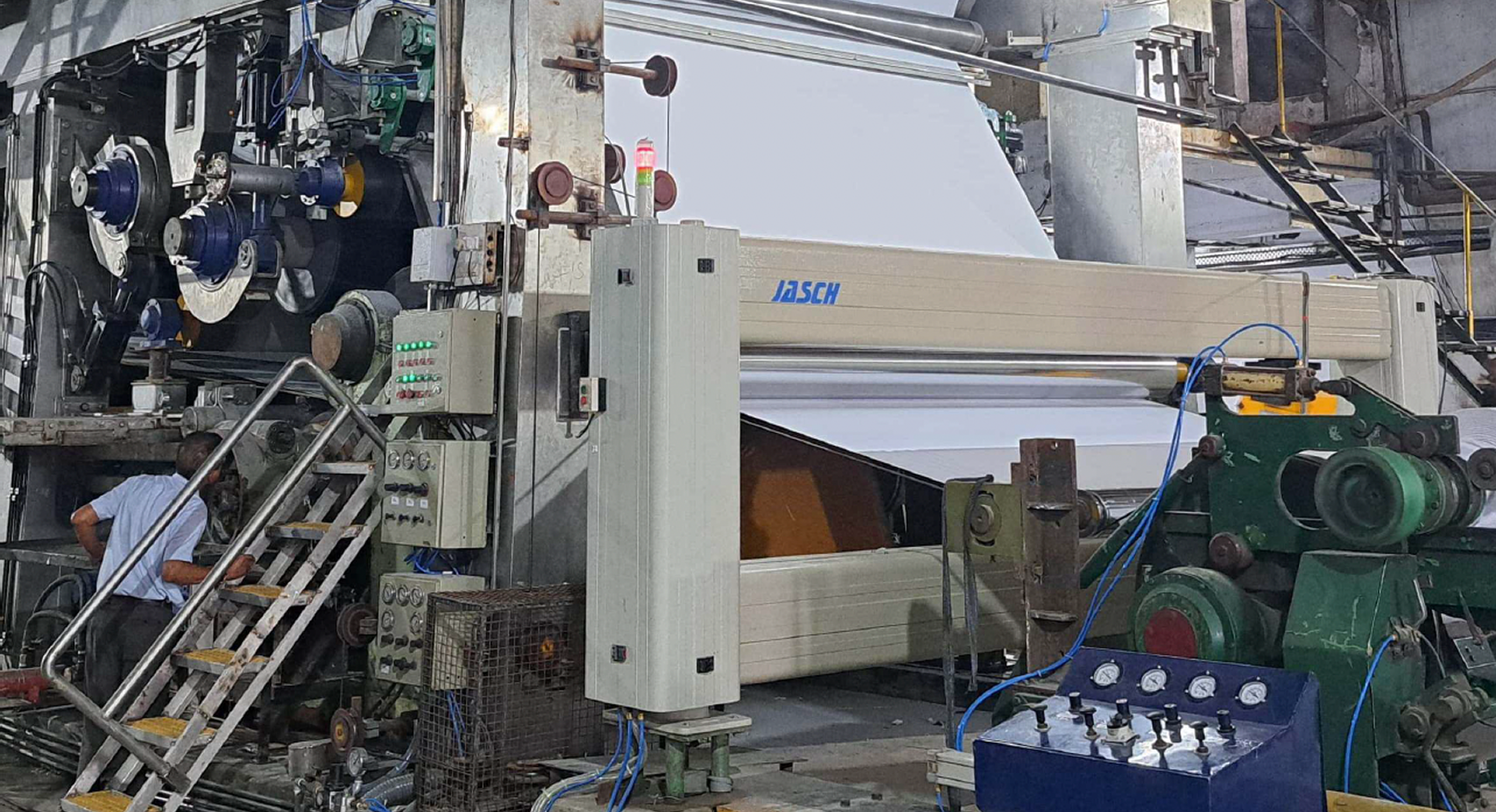
The immediate benefits of this transition were evident. The Jasch QCS significantly reduced CD variations and enhanced overall operational efficiency. For the first time, technology empowered the team to proactively control the process instead of merely reacting to issues as they arose. This adoption of automation marked a key turning point in Chandpur Paper’s operational journey.
Previously, basis weight control relied heavily on manual systems, which lacked the capability for consistent measurement or regulation within the machine chest. This deficiency necessitated a carefully engineered approach to flow management, along with optimized process parameters and meticulous fine-tuning of the entire system. To build on these improvements, Chandpur Paper installed a consistency transmitter and set it
to automatic mode, further enhancing the precision and stability of their operations.

“At Chandpur Paper, we believe that quality is a journey, not a destination. The more we refine our processes, the better our products become. We’re committed to ongoing improvement, always striving to achieve the highest standards of excellence.”
DK Singhal
Technical director, Chandpur Paper
The Key Upgrade
Adopting the Hydraulic Headbox
Just when it seemed like the Jasch QCS was succeeding, a new challenge presented itself. To continue its upward trajectory, Chandpur Paper embarked on an even more ambitious project—replacing the conventional pressurized headbox with a hydraulic one featuring CD dilution profile control.
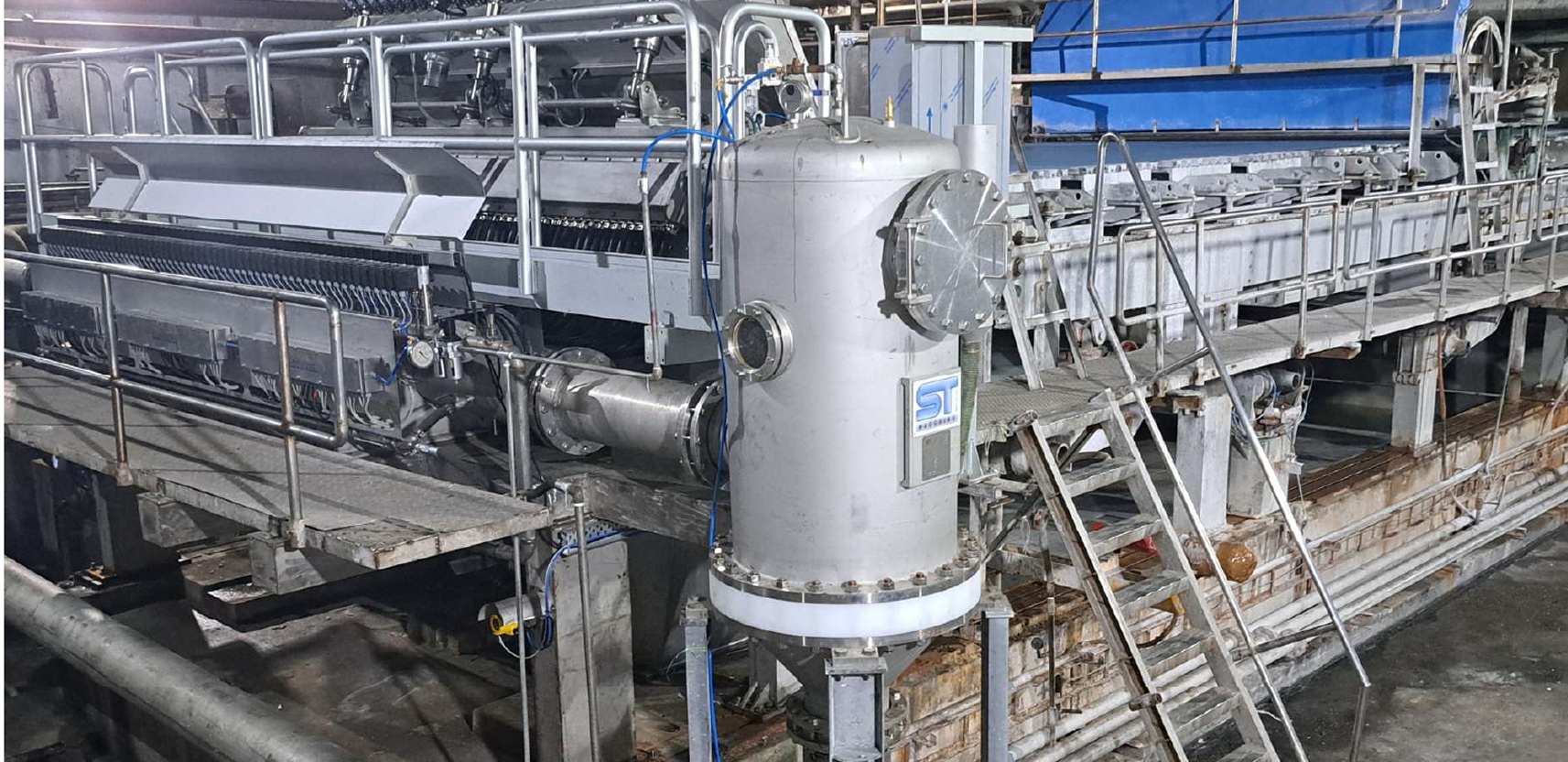
This upgrade was no small feat. With its automatic actuator-controlled dilution valves, the hydraulic headbox promised to deliver far superior gsm control, without constant manual intervention. But as with any new technology, the team must learn, adapt, and master it. Initially, the operators struggled to adjust to the new system. It felt unfamiliar and challenging compared to the old setup.
However, Chandpur Paper believes in empowering its workforce. Through one-on-one training sessions and hands-on experience, operators were not only trained but encouraged to experiment with the new headbox during commissioning and fine-tuning. This approach turned them into active participants in the innovation process rather than passive users. In no time, they gained confidence, and the results began to speak for themselves.
Introducing 2-Sigma
Enhancing Precision with Data
With the hydraulic headbox in place, Chandpur Paper wasn’t content with merely maintaining acceptable standards. Driven by a commitment to continuous improvement, the team adopted a widely recognized industry best practice—2-sigma (2-σ) analysis—to further refine their processes.
2-sigma, a statistical measure often used to evaluate variability, represents a range where 95% of the data points fall within two standard deviations from the mean. For Chandpur Paper, this method became a reliable performance indicator to ensure their paper’s gsm levels remained consistent. For instance, when producing 40 gsm paper, a 2-sigma of 0.5 gsm would mean that over 95% of samples would fall within the range of 39.5 to 40.5 gsm, reflecting a high degree of precision.
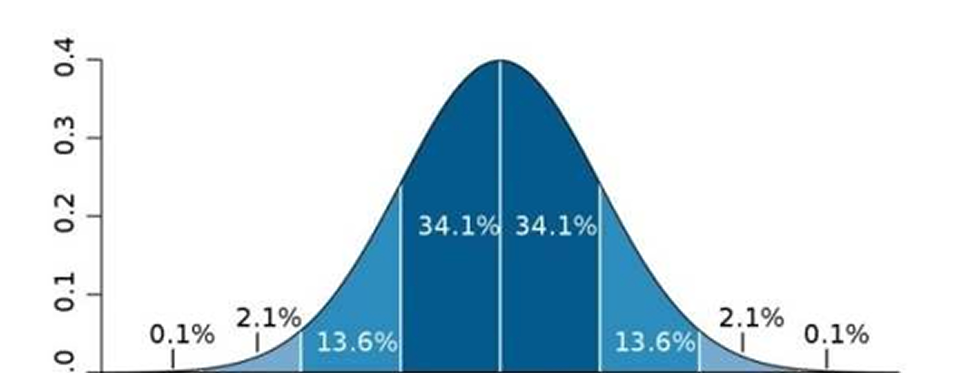
By adopting 2-sigma measurement as a benchmark for quality, Chandpur Paper aligned itself with industry best practices, reinforcing its reputation for excellence. This focus on consistency and precision not only elevated their standing within the company but also strengthened trust among their clientele.
Confronting Software Limitations
A Return to Manual Analysis
These steady improvements gave the team confidence to pursue perfection. Chandpur Paper soon discovered that their scanner software had limitations when it came to analyzing MD variations. To overcome this hurdle, they returned to their roots—manual time series analysis. Over 800 samples were manually analyzed, revealing new issues into the consistency control loop.
Fine-tuning the PID parameters based on this analysis resulted in even better outcomes than initially expected. While the CD profile was being controlled automatically, the variations generated in the MD (machine direction) were due to underlying issues in approach flow. These issues were identified and corrected to achieve even better CD control along with good MD control.
Once again, the company’s commitment to continual improvement proved its worth, showcasing that sometimes the old methods, combined with new technology, can yield the best results

GSM Graph
Rediscovering precision: This manually analyzed GSM graph highlights the team’s return to hands-on methods, uncovering key insights into MD and CD variations and overcoming software limitations for a better process control.
The People Behind the Success
Empowering Operators and Expert Collaboration
At the heart of this success story stand Chandpur Paper’s operators, who played an instrumental role in mastering new technologies and fine-tuning processes. Through their hands-on experience, they became the real heroes of this journey.
The company also benefited from external partnerships. Mr. Mukesh Kumar from ST Macchine, who had once taught Mr. D.K. Singhal during his Master’s program, provided valuable feedback on improving the 2-sigma targets. Other experts like Wolfgang Griech, the developer of the CD control software, shared insights that helped overcome some of the software-related challenges.
Results and Milestones
Achieving New Standards in Quality
The results of Chandpur Paper’s journey toward zero gsm variance were impressive. CD 2-sigma values, which initially ranged between 1.2 and 1.4, dropped to a remarkable 0.5 to 0.7 range. This achievement was shared and celebrated with their technology partners, marking the culmination of years of dedication, innovation, and teamwork.

Real-World Impact on Consumer Products
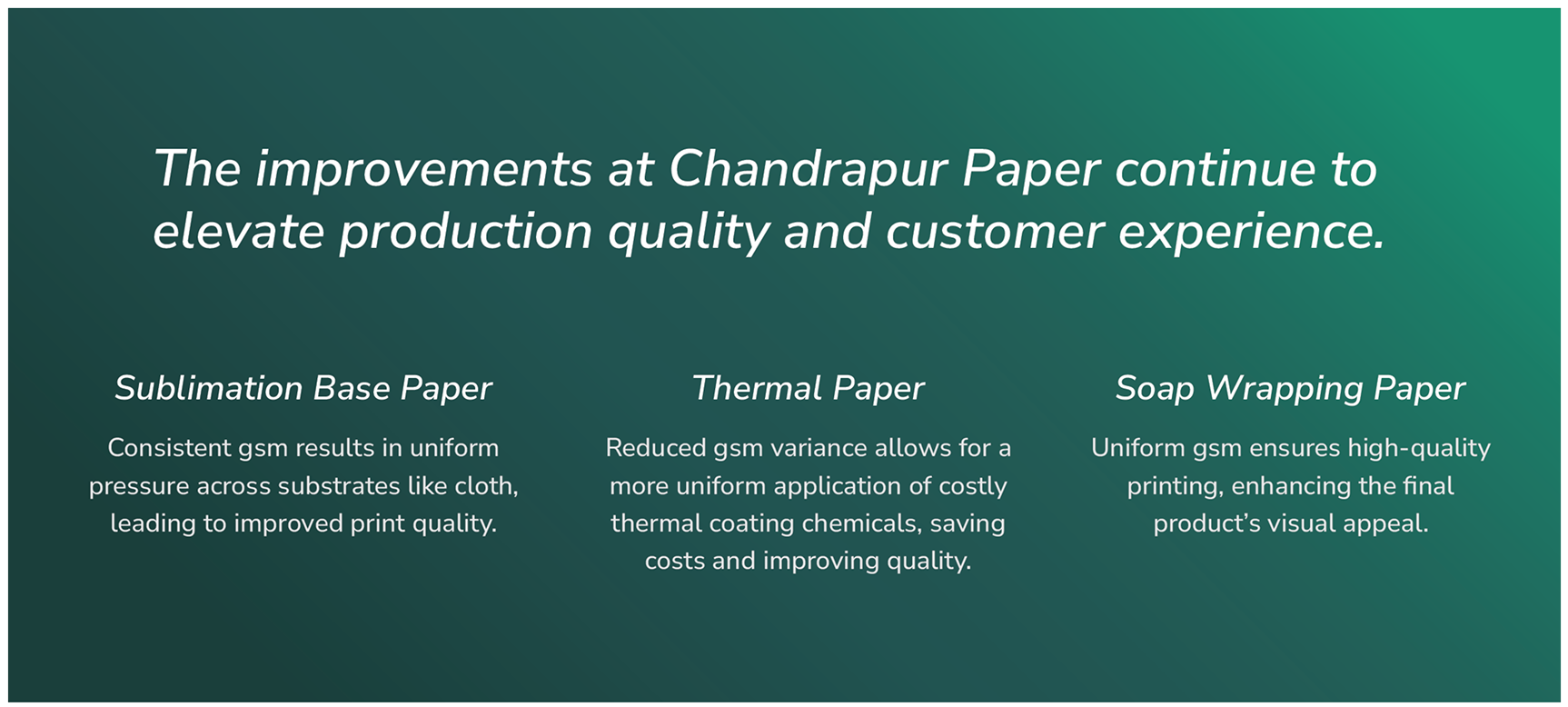
A Commitment to Continuous Improvement

Chandpur Paper’s story is one of continual growth. While they’ve achieved remarkable success, their journey toward perfecting basis weight control is ongoing. They remain committed to setting new benchmarks for themselves and the industry, pushing the boundaries of quality and performance in paper manufacturing.
As their journey continues, one thing is clear: Chandpur Paper has positioned itself as a leader in both innovation and quality, driven by technology, data, and, most importantly, its people.
